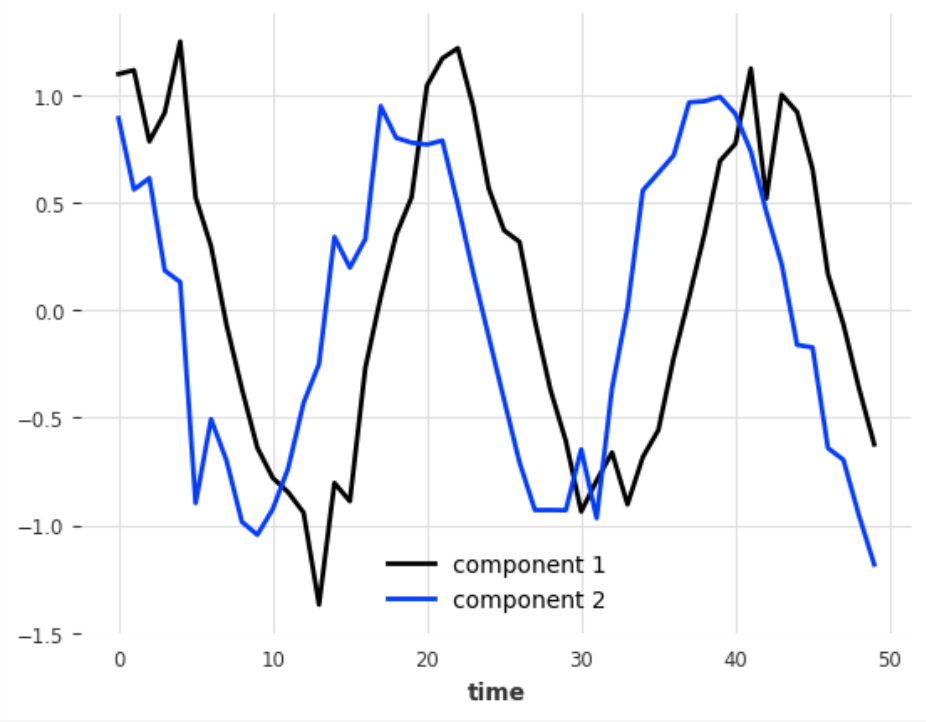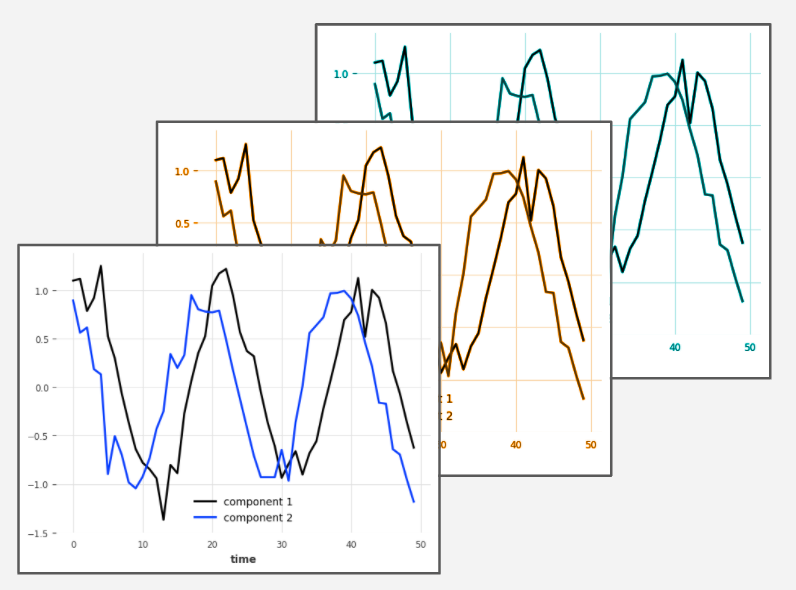TimeSeries#
TimeSeries is the main data class in Darts. A TimeSeries represents a univariate or multivariate time series, with a proper time index. The time index can either be of type pandas.DatetimeIndex (containing datetimes), or of type pandas.RangeIndex (containing integers; useful for representing sequential data without specific timestamps). In some cases, TimeSeries can even represent probabilistic series, in order for instance to obtain confidence intervals.
TimeSeries are used in Darts in order to offer a consistent API dedicated to time series:
TimeSeriesare guaranteed to have a proper time index (integer or datetime based): complete and time-sorted.All models in Darts consume
TimeSeriesand produceTimeSeries.TimeSeriesallows to do all sort of time series operations (such as splitting at timestamps, concatenating, etc).TimeSeriesoffers user-friendly way to represent multidimensional and probabilistic series (e.g. obtain marginal quantiles).
Using a dedicated type to represent time series (instead of say, Pandas DataFrame, NumPy array, …) removes the need to rely on conventions about the formats expected by the different models and functions.
Multivariate time series -vs- multiple time series#
We distinguish univariate from multivariate series:
A multivariate series contain multiple dimensions (i.e. multiple values per time step).
A univariate series contains only one dimension (i.e., single scalar value for each time step).
Sometimes the dimensions are called components. A single TimeSeries object can be either univariate (if it has a single component), or multivariate (if it has multiple components). In a multivariate series, all components share the same time axis. I.e., they all share the same time stamps.
Some models in Darts (and all machine learning models) support multivariate series. This means that they can take multivariate series in inputs (either as targets or as covariates), and the forecasts they produce will have a dimensionality matching that of the targets.
In addition, some models can work on multiple time series, meaning that they can be trained on multiple TimeSeries objects, and used to forecasts multiple TimeSeries objects in one go. This is sometimes referred to as panel data. In such cases, the different TimeSeries need not share the same time index – for instance, some series might be in 1990 and others in 2000. In fact, the series need not even have the same frequency. The models handling multiple series expect Python Sequences of TimeSeries in inputs (for example, a simple list of TimeSeries).

Figure 1: A single multivariate series. In Darts this is represented by a single TimeSeries object.

Figure 2: Multiple time series. In Darts this is represented by multiple TimeSeries objects. The series may or may not share the same time axis, and may or may not be multivariate.
Example of a multivariate series: The blood pressure and heart rate of a single patient over time (one multivariate series with 2 components).
Example of multiple series: The blood pressure and heart rate of multiple patients; potentially measured at different times for different patients (one multivariate series with 2 components per patient).
Should I use a multivariate series or multiple series for my problem?#
Using multivariate series will provide an opportunity for models to capture the dimensions jointly, whereas using multiple series will expose the models to multiple observations. So which representation is right is problem-dependent, and in some cases might not even be clear beforehand and require experimentation. Nevertheless, if you are in a situation where you are trying to model several “correlated” components varying together across time (e.g. the coordinates of a moving object, or multiple measurements related to a single entity), it is often natural to capture those as multiple components in single series. If on the other hand you have several instance of such measurements (e.g., obtained in different experiments or observations), this can mean that you have multiple time series. Furthermore, if your values do not share the same time spans, they should probably be represented as different series.
Probabilistic and deterministic series#
In Darts, probabilistic forecasts are represented by drawing Monte Carlo samples from the underlying probabilistic models. This representation allows TimeSeries to represent arbitrary joint distributions (over time and components) without relying on any pre-defined parametric form. Based on this, we define two types of time series:
A Probabilistic (or stochastic) series contains multiple samples.
A deterministic series contains only one sample.
Creating TimeSeries#
TimeSeries objects can be created using factory methods, for example:
TimeSeries.from_dataframe() can create
TimeSeriesfrom a Pandas Dataframe having one or several columns representing values (columns correspond to components, and several columns would correspond to a multivariate series).TimeSeries.from_values() can create
TimeSeriesfrom a 1-D, 2-D or 3-D NumPy array. It will generate an integer-based time index (of typepandas.RangeIndex). 1-D corresponds to univariate deterministic series, 2-D to multivariate deterministic series, and 3-D to multivariate stochastic series.TimeSeries.from_times_and_values() is similar to
TimeSeries.from_values()but also accepts a time index.
More methods are documented in the TimeSeries API documentation.
Furthermore, it is possible to concatenate series along different axes using the function concatenate(). axis=0 corresponds to time, axis=1 corresponds to component and axis=2 correspond to stochastic sample dimensions. For instance:
from darts import concatenate
my_multivariate_series = concatenate([series1, series2, ...], axis=1)
produces a multivariate series from some series that share the same time axis.
Implementation#
Behind the scenes, TimeSeries is wrapping around a 3-dimensional xarray.DataArray object. The dimensions are (time, component, sample), where the size of the component dimension is larger than 1 for multivariate series and the size of the sample dimension is larger than 1 for stochastic series. The DataArray is itself backed by a 3-dimensional NumPy array, and it has a time index (either pandas.DatetimeIndex or pandas.RangeIndex) on the time dimension and another pandas.Index on the component (or “columns”) dimension. TimeSeries is intended to be immutable and most operations return new TimeSeries objects.
Exporting data from a TimeSeries#
TimeSeries objects offer a few ways to export the data, for example:
TimeSeries.to_dataframe() to export a Dataframe (for deterministic series)
TimeSeries.data_array() to export the
xarrayDataArrayholding this series’ data (and indexes).TimeSeries.values() to export a NumPy array containing the values of one sample from the series.
TimeSeries.all_values() to export a NumPy array containing the values of all samples of a stochastic series.
Static Covariates#
Optionally, TimeSeries objects can contain static data (referred to as static covariates), which can be exploited by some models. Example of static covariates can be:
Store location - for instance for each store (component) in a multivariate series
Product ID
Sensor type
…
The static covariates have to be specified by a pandas DataFrame whose rows match the TimeSeries‘s components, and whose columns represent the dimensions of the static covariates. They can be added to a TimeSeries when using most factory methods, using the static_covariates parameter. They can also be added to an existing TimeSeries using the with_static_covariates() method.
Hierarchical Time Series#
Optionally, TimeSeries objects can contain a hierarchy, which specifies how its different components are grouped together. The hierarchy itself is specified as a Python dictionary, mapping the components’ names to a list of names of their parent(s) in the hierarchy.
For instance, the following hierarchy means that the two components "a" and "b" add up to "total":
hierarchy = {"a": ["total"], "b": ["total"]}
Hierarchies can be used for posthoc forecast reconciliation. Darts offers several reconciliation transformers (usable with fit()/transform()) - see the corresponding API documentation.
More information and documentation#
The full list of attributes and methods of the TimeSeries class is listed in the API Documentation. In addition, the Quickstart contains some examples of TimeSeries manipulation.

